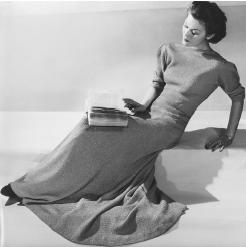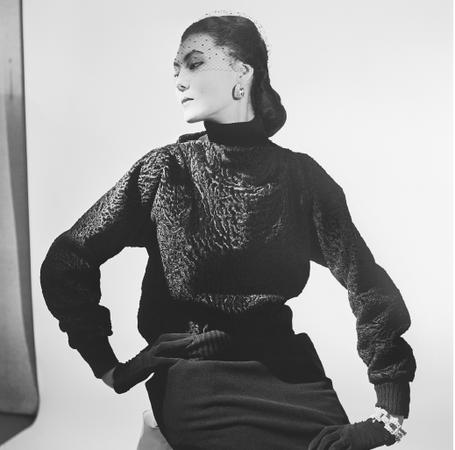Elsa Schiaparelli - Fashion Designer Encyclopedia
French designer
Born: Rome, 10 September 1890. Family: Married Comte William de Wendt de Kerlor, 1914 (separated); children: Yvonne ("Gogo").
Career: Lived in New York working as scriptwriter and translator, 1919-22 and 1941-44; immigrated to Paris, 1923; showed first collection, 1925; house of Schiaparelli operated, 1928-54; London branch opened, 1933, girls' debutante department added, 1935; Schiaparelli Paris boutique opened, 1935; lecturer on fashion, 1940, and volunteer in U.S. for French war effort, 1941-43; fragrances include Salut, Soucis, and Schiap, 1934; Shocking, 1937; Sleeping, 1938; Snuff for men, 1939; Le Roi Soleil, 1946; Zut, 1948; Succés Fou, 1953; Si, 1957; and S, 1961. Exhibitions: Hommage á Elsa Schiaparelli, Pavillon des Arts, Paris, 1984; Fashion and Surrealism, Fashion Institute of Technology, New York, and Victoria and Albert Museum, London, 1987-88; Elsa Schiaparelli, Brooklyn Museum, 1995-96. Awards: Neiman Marcus award, 1940. Died: 13 November 1973, in Paris.
Publications
By SCHIAPARELLI:
Books
Shocking Life, London, 1954.
On SCHIAPARELLI:
Books
Flanner, Janet, An American in Paris, New York, 1940.
Bertin, Celia, Paris á la Mode: A Voyage of Discovery, London, 1956.
Latour, Anny, Kings of Fashion, London, 1958.
Hommage á Elsa Schiaparelli [exhibition catalogue], Paris, 1984.


Milbank, Caroline Rennolds, Couture: The Great Designers, New York, 1985.
White, Palmer, Elsa Schiaparelli, New York, 1986.
Martin, Richard, Fashion and Surrealism, New York, 1987.
Leese, Elizabeth, Costume Design in the Movies, New York, 1991.
Steele, Valerie, Women of Fashion: Twentieth Century Designers, New York, 1991.
White, Palmer, Elsa Schiaparelli: Empress of Fashion, New York, 1995.
Stegemeyer, Anne, Who's Who in Fashion, Third Edition, New York, 1996.
Baudot, François, Schiaparelli, New York, 1997.
Cawthorne, Nigel, Key Moments in Fashion, London, 1998.
Articles
Wilson, Bettina, "Back to Paris with Elsa Schiaparelli," in Vogue (London), October 1945.
"Schiaparelli the Shocker," in Newsweek, 26 September 1949.
Sheppard, Eugenia, ''Schiaparelli's Dim View of Today," in The Guardian, 11 August 1971.
"Elsa Schiaparelli," [obituary] in the New York Times, 15 November 1973.
"Berry—We Called Her Schiap," in American Fabrics and Fashions (New York), No. 100, Spring 1974.
"Schiaparelli sa vie en rose—shocking," in Elle (Paris), 6 August 1984.
Moutet, Anne Elizabeth, "A Shocking Affair," in Elle (London), October 1986.
Lawford, Valerie, "Encounters with Chanel, Mainbocher, Schiaparelli, Valentina, and Charles," in Architectural Digest, September 1988.
White, Edmund, "The Jewelry Designer's Crush on Schiaparelli…," in Architectural Digest, September 1989.
McCooey, Meriel, "Strung Along," in the Sunday Times Magazine (London), 21 April 1991.
Menkes, Suzy, "Elsa Schiaparelli: Shocking Life on the rue de Berri in Paris," in Architectural Digest, October 1994.
Smith, Roberta, "In Schiaparelli's Hands, Women as Works of Art," in the New York Times, 18 December 1995.
Cuccio, Angela, "Elsa Schiaparelli: The Roman Who Was the Sensation of Paris Through the 1930s, Looks Forward," in WWD, 13 September 1999.
***
Elsa Schiaparelli considered designing an art rather than a profession, making the unconventional acceptable. Born into a high ranking Italian family, her creativity was influenced by accepting the visually rich and rebelling against her extremely regulatory and proper upbringing. Much of her extravagance was inspired by the proper yet dramatic vestments of the priests and nuns remembered from her youth in Rome, combined with the city's architecture, magnificent medieval manuscripts, and ancient Greco-Roman mythology from the library where her father worked. The opulent and fanciful bead-work and embroidery Schiaparelli later produced in Paris was reminiscent of stained glass windows and had its roots in her youth in Italy. Other influences in her work were the futurists, cubists, New York dadaism, Parisian surrealists, and art déco.
Schiaparelli began designing gowns for herself and friends in 1915, with help and influence from Paul Poiret. She was an inventor of clothes; her clothes were immediately considered avant-garde, individualistic, eccentric, yet easy to wear. Sportswear, coordinated beachwear, and matching bags and shoes characterized her early work. Unusual fabrics such as upholstery material and terrycloth for beachwear and zippers on ski ensembles were characteristic.
Schiaparelli was a contemporary of Chanel. They worked during the same period and both started out designing sweaters—yet these are the only similarities they shared. Schiaparelli's initial success came with her tromp l'oeil sweater featuring a knitted-in bow at the neckline. So influential were these sweaters that additional designs followed, which included belts, handkerchiefs, and men's ties, all utilizing the unique methods of Armenian knitters. The immediate success of her sweaters allowed Schiaparelli to open her own shop on the rue de la Paix, the most fashionable street in Paris in 1927. An amazing success, it was estimated that by 1930 her company's income was approximately 120 million francs per year and her workrooms employed more than 2,000 people. She introduced good working-class clothes into polite society and understood how snob appeal worked through pricing.
After the Great Depression, fashion was in desperate need of excitement. Schiaparelli was to answer this call—she shocked as well as entertained the public, believing good taste was less important than creativeness, outrageousness, and fun. It was her belief that women should dare to be different, and through wearing attention-seeking clothes, a woman became chic. Utilizing wit and shock tactics to arm modern women, Schiaparelli believed they would gain equality and independence.
The extraordinary and unusual were expected of Schiaparelli; she didn't disappoint. She was the first couturier to use brightly colored zippers, using them initially on sportswear, beginning in 1930, and reintroducing them in 1935 on evening dresses. She collaborated with fabric houses to develop unusual novelty prints and unique materials. When Rhodophane, a cellophane material, was invented, she made glass-like tunics. Schiaparelli was known for such fabrics as "anthracite," a coal-like rayon; "treebark," a matte crêpe crinkled in deep folds to look like bark; and fabrics printed with newsprint.
Her commissions of contemporary artists were legendary—they included Christian Bérard, Jean Cocteau, and Salvador Dali. Their collaborations led to such eccentric designs as the lamb-cutlet hat, the brain hat, the shoe hat, and the suit with pockets that simulated a chest of drawers. She also incorporated oversized buttons in the shape of peanuts, bumblebees, and rams' heads. Her basic silhouettes were often simple and easy-to-wear, but through witty embellishments on a variety of themes such as the military, the zodiac, and the circus, they became unique. Through the study of Tunisian methods of sewing, draping, and veil twisting, Schiaparelli brought Arab breeches, embroidered shirts, and wrapped turbans to Paris fashion, as well as huge pompom-rimmed hats, barbaric belts, jewelry, and the "wedgie"—a two-inch-soled shoe that would be a trend throughout the 20th century and into the next.
There was also a more cautious side to Schiaparelli, which appealed to the somewhat more conservative woman. For this woman, her severe suits and plain black dresses were appealing. To her tailored ensembles she added trousers and unconsciously influenced the mix-and-match sportswear concept which wasn't fully recognized for the next 40 to 50 years. She showed her trouser suits for every occasion—travel, citywear, evening, and sports. After the acceptance of these slimmer, more slender divided skirts as they were called, she took the next step and shortened them, thus creating the culotte.
Black and the combination of black with white were favorites of Schiaparelli. In 1936 she launched shocking pink, a brilliant pink somewhere between fuchsia and red, and it became the hallmark of her couture house. Schiaparelli's influence can still be seen today in the masculine chic looks, the surrealistic accessories, and ornate buttons. She broke down the walls dividing art and fashion and anticipated the 21st century's eclectic approach to designing. Elsa Schiaparelli remains an everlasting influence on contemporary fashion.
—Roberta H. Gruber;
updated by Nelly Rhodes
Comment about this article, ask questions, or add new information about this topic: